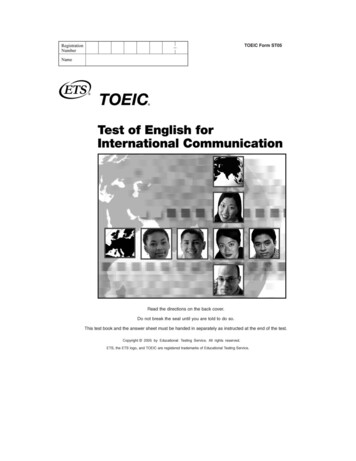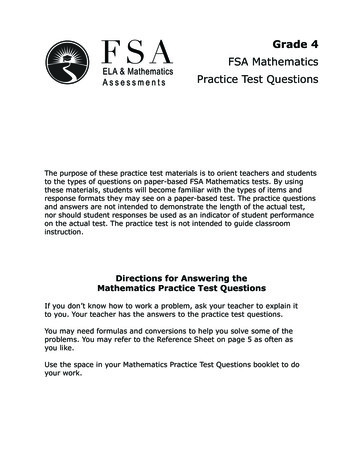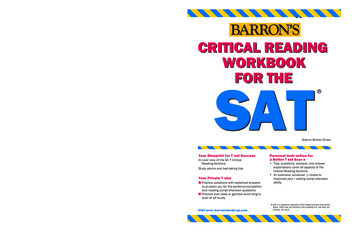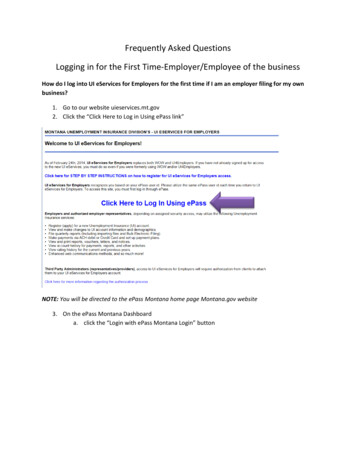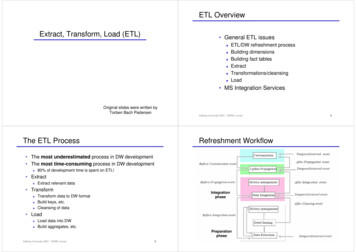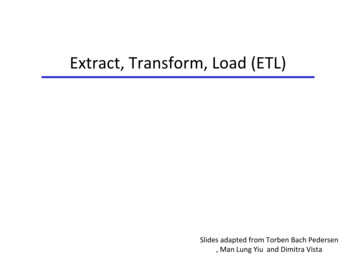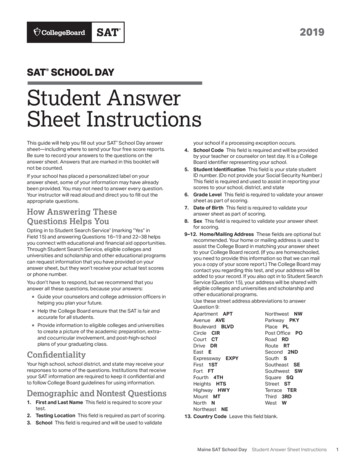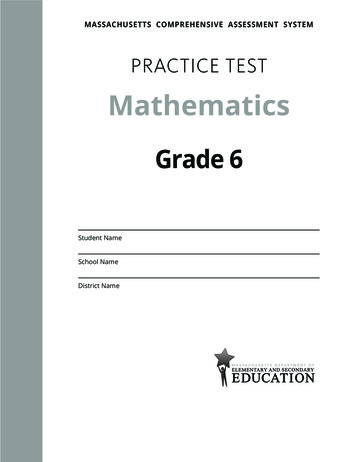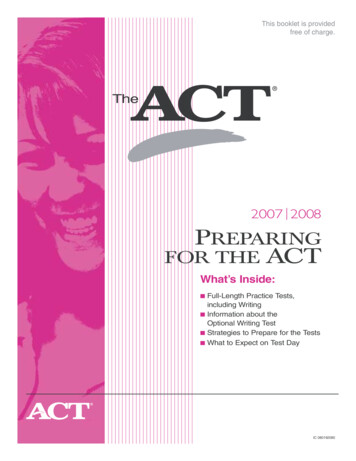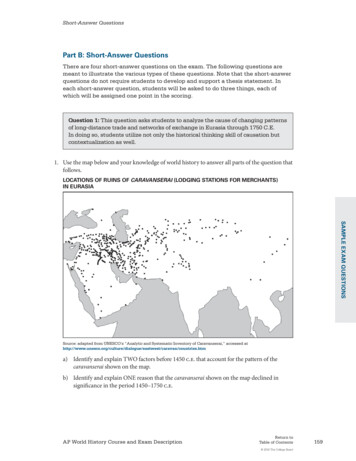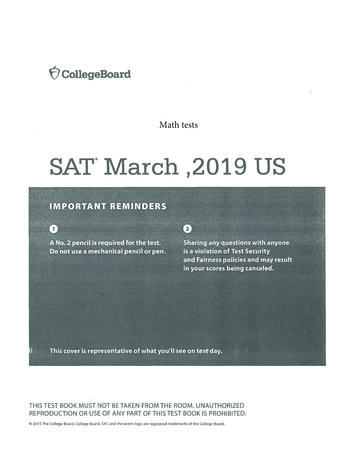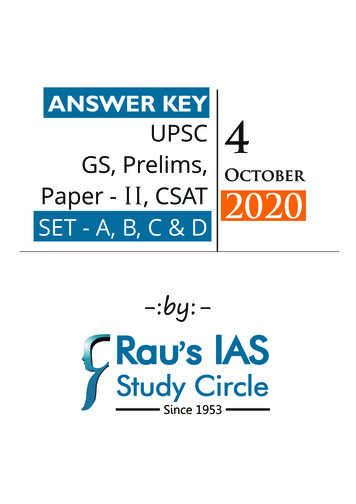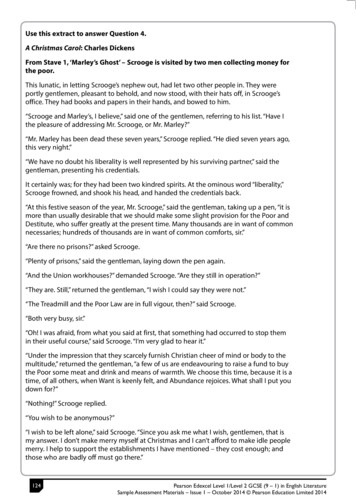
Transcription
Use this extract to answer Question 4.A Christmas Carol: Charles DickensFrom Stave 1, ‘Marley’s Ghost’ – Scrooge is visited by two men collecting money forthe poor.This lunatic, in letting Scrooge’s nephew out, had let two other people in. They wereportly gentlemen, pleasant to behold, and now stood, with their hats off, in Scrooge’soffice. They had books and papers in their hands, and bowed to him.“Scrooge and Marley’s, I believe,” said one of the gentlemen, referring to his list. “Have Ithe pleasure of addressing Mr. Scrooge, or Mr. Marley?”“Mr. Marley has been dead these seven years,” Scrooge replied. “He died seven years ago,this very night.”“We have no doubt his liberality is well represented by his surviving partner,” said thegentleman, presenting his credentials.It certainly was; for they had been two kindred spirits. At the ominous word “liberality,”Scrooge frowned, and shook his head, and handed the credentials back.“At this festive season of the year, Mr. Scrooge,” said the gentleman, taking up a pen, “it ismore than usually desirable that we should make some slight provision for the Poor andDestitute, who suffer greatly at the present time. Many thousands are in want of commonnecessaries; hundreds of thousands are in want of common comforts, sir.”“Are there no prisons?” asked Scrooge.“Plenty of prisons,” said the gentleman, laying down the pen again.“And the Union workhouses?” demanded Scrooge. “Are they still in operation?”“They are. Still,” returned the gentleman, “I wish I could say they were not.”“The Treadmill and the Poor Law are in full vigour, then?” said Scrooge.“Both very busy, sir.”“Oh! I was afraid, from what you said at first, that something had occurred to stop themin their useful course,” said Scrooge. “I’m very glad to hear it.”“Under the impression that they scarcely furnish Christian cheer of mind or body to themultitude,” returned the gentleman, “a few of us are endeavouring to raise a fund to buythe Poor some meat and drink and means of warmth. We choose this time, because it is atime, of all others, when Want is keenly felt, and Abundance rejoices. What shall I put youdown for?”“Nothing!” Scrooge replied.“You wish to be anonymous?”“I wish to be left alone,” said Scrooge. “Since you ask me what I wish, gentlemen, that ismy answer. I don’t make merry myself at Christmas and I can’t afford to make idle peoplemerry. I help to support the establishments I have mentioned – they cost enough; andthose who are badly off must go there.”10124Pearson Edexcel Level 1/Level 2 GCSE (9 – 1) in English LiteratureS47442ASample Assessment Materials – Issue 1 – October 2014 Pearson Education Limited 2014
Question 4 – A Christmas Carol4 (a) Explore how Dickens presents Scrooge’s character in this extract.Give examples from the extract to support your ideas.(20)(b) In this extract, poverty is discussed.Explain how Dickens portrays poverty elsewhere in the novel.In your answer you must consider: what poverty is shown how poverty affects those involved.(20)(Total for Question 4 40 marks)Pearson Edexcel Level 1/Level 2 GCSE (9 – 1) in English LiteratureS47442ASample Assessment Materials – Issue 1 – October 2014 Pearson Education Limited 201411125Turn over
Candidate 14a) Explore how Dickens presents Scrooge’s character in this extractIn this extract, Dickens presents Scrooge’s character as mean, greedy and rude.The extract initially shows us that Scrooge is an important person, with theevidence being that the gentlemen ‘bowed to him’ and ‘took their hats off.’ It isinteresting that these are ‘gentlemen’ but they still feel the need to ‘bow’ toScrooge, showing how highly regarded he is.We also learn that Scrooge thinks that business is the most important thing inlife, thanks to the conversation about ‘Scrooge and Marley’s’ as the name of thebusiness. Scrooge has not changed the business name as he wants to maintainits reputation. This shows how important reputation was in the Victorian era.It also appears that Scrooge is not that upset about Marley’s death, which issuggested by the phrase ‘Dead these seven years.’ This phrase is repeated inthe extract, but delivered without emotion, suggesting that Scrooge does notfeel upset or angry, and perhaps suggesting a lack of ability to care for people.This is backed up by the fact that he does not like the word ‘liberality’ as itinvolves spending his money on other people.This idea has an impact on his feelings towards the poor. These negative feelingsare highlighted by the quote ‘Are there no prisons?’ which is a rhetoricalquestion. Scrooge, like many wealthy people of the era, thought that poorpeople should be sent to the workhouses and prisons, without reallyunderstanding what that means.Scrooge is also careful with money. We know this because of the quote ‘I can’tafford to make idle people merry.’ This is ironic as he can afford to make peoplemerry, but he does not because he is rich and he wishes to remain rich - whichfor him does not involve helping the poor.4b) In this extract, poverty is discussed. Explore how Dickens presentspoverty in ‘A Christmas Carol’Dickens presents poverty as a major theme in the book. We know this as thebook is set during the Industrial Revolution where many families were forced toshare houses and rooms with other families and poverty was a major issue.People ‘in the streets’ are described in the novel to represent normal people,who face poverty every day. They are described as being ‘happy’ because it isChristmas, which shows that being poor does not mean being unhappy.The Clerk, Bob Cratchit, is a character in the book who represents the poor. Adirect contrast is provided when he has only one piece of ‘coal’ to heat up hisroom, when his employer, Mr Scrooge, has lots - although he doesn’t use it. Healso has no ‘coat,’ because he needs all his money to pay for his wife andchildren. This shows the wealth gap that existed at the time.
Charles Dickens wrote ‘A Christmas Carol’ to tell people that the poor people ofthe time were extremely poor and the rich people, like Scrooge, wereunnecessarily rich. Scrooge says ‘Humbug!’ to everything like rich people at thetime ignored the poor, which was what Dickens was trying to stop fromhappening.Student 1MarkCommentaryLevel 4 - 15The candidate has produced a detailed responseexploring the presentation of Scrooge and how he is a‘mean, greedy and rude’ man. A range of textualexamples are made to accurately support each pointand the analysis is sustained. Exploration is made tothe use of rhetorical questions and repetition and theeffect these have on the reader. Subject terminologyis accurate.Level 2 - 7The response is largely narrative but has somepersonal engagement and valid points are made of howpoverty is presented elsewhere in the novel. Thecandidate considers the character of Bob Cratchit andhow he only has ‘one piece of coal to heat up hisroom.’4a)4b)
Candidate 24a) Explore how Dickens presents Scrooge’s character in this extractDickens presents Scrooge’s character in this extract as stubborn, selfish andrude. He wishes nothing to do with the two gentlemen and wishes “to be leftalone.”Scrooge is also shown to be self-centred. He believes that the poor do not needor deserve to be helped by being given comfort and food. He believes that healready pays enough taxes for the “workhouses” where he they should go.Dickens portrays Scrooge as a shallow and uncharitable to represent thebusiness owners of the day who did not engage with charity.Though the gentlemen in the extract are very polite to Mr Scrooge, he does notgive them the same kindness back, as when the gentlemen asked Scrooge howmuch money he should be put down for, Scrooge replied “Nothing!” abruptly.Dickens use of the a short sentence and exclamation here shows that Scrooge isvery against giving up any money for charity, to the extent of being angry at thesuggestion. His abruptness shows that he would do everything in his power tomake the two kind gentlemen disappear.The rhetorical questions “Are there no prisons?” “And union workhouses?” areused to show where Scrooge believes the poor people belong, suggesting that hebelieves his status suggests that poverty is not directly relevant to him, and thatnothing to do with the poor matters.In this extract I definitely think that Dickens was trying propose that Scrooge’scharacter is very negative and that he doesn't have any love or kindness in hisheart. This establishes Scrooge, early in the novel, as being an evil character.4b) In this extract, poverty is discussed. Explore how Dickens presentspoverty in ‘A Christmas Carol’Dickens presents poverty in ‘A Christmas Carol’ as being a very big problem inthe Victorian era following the industrial revolution. Various aspects of the plotare about poverty and what happens to the people who are in poverty.At this time of year, at christmas charity collectors come round collecting for thepoor as it is a time of giving, yet Scrooge give “Nothing!” The reader willrecognise that many would react in this way and that Scrooge surely will not bethe only person who has not donated. Many businessmen who think like Scroogeat this time, motivated by self interest, will have done the same thing. Thetragedy here is that this is the time of year when people give the most. So this iswhen the most money is donated, but some people are not giving at all, forcingthe reader to question what must it be like throughout the rest of the year.Dickens also displays poverty through the Cratchit family, and how they do nothave enough money for medical care to help poor “little” Tiny Tim, whichhighlights the difficulty of the lives of poor people at the time. However, Dickens
also has other messages to deliver about the poor. When the Cratchit family sitdown for their Christmas dinner, Dickens makes out in the dialogue that theyview their meal as large and plentiful; ‘nobody said or thought it was at all asmall pudding for a large family.’ The reality is quite different. For thisimpoverished family the meal is many times larger than any other they wouldhave, but it is still meagre. The fact that they can make the best of it shows thatpoor people are not necessarily bad people.Dickens makes regular reference to the fact that during the industrial revolutiontime many poor and underprivileged people will have been sent away to either“union workhouses” or “prisons.” The regular references show that society didnot know the reality of these places, and that many people did not realise thatthey should help. This is the realisation that the reader is supposed to makewhen reading the novel. Charles Dickens definitely tries to prove to people howbig an issue poverty was becoming in Victorian London in ‘A Christmas Carol’and to highlight the fact that no-one was trying to prevent it.Mark4 a)4 b)Level 4 - 15Level 4 - 16CommentaryA focused response, which covers a number of pointsconcerning the presentation of Scrooge as a ‘selfishand rude’ character. Points are well supported withevidence from the text and the effect of language onthe reader is sustained. The candidate uses subjectspecific terms to analyse the use of rhetoricalquestions and sentence structuring.A sustained and developed response analysing thepresentation of poverty in the novel, through the useof the ‘charity collectors collecting for the poor’, thepoverty of the Cratchit family and their meagreChristmas meal and the discussion of ‘workhouses’and ‘prisons’. There are relevant and well-chosenreferences to the text to support the points made.
Candidate 34a) Explore how Dickens presents Scrooge’s character in this extractDickens presents Scrooge’s character in the extract in many different ways.Firstly, he shows Scrooge’s class - upper/middle class - through the use of thesetting ‘Scrooge’s office’. This setting establishes for the reader that he is richenough to own his own office, and to be an employer, which establishes him asrepresentative of this part of society.Dickens then describes and characterises Scrooge as a moody, negative andcruel person. His reaction to being asked to donate to charity was to answer witha very strong ‘Nothing!’ and, when asked about the poor he replies with therhetorical questions ‘Are there no prisons?’ ‘And the union workhouses?’ Hisanswer tells the reader that he, and his kind, would rather the poor be sent toworkhouses or prisons than him waste money on them. There is a definite lackof care present for other human beings, which may force the reader to questiontheir own attitude to charity.Another way in which Dickens describes Scrooge is as an outsider, because heisolates himself away from everyone else. For example, the short sentence ‘Iwish to be left alone’ shows that he is definitely an outsider not an outcast - hehas made a conscious decision to separate himself from society rather thanbeing forced from it. This side of Scrooge is structurally important as it makesthe reader wonder why Scrooge is like this and question his actions.Having said that, although it seems that he is an outsider by the point of timethe extract is set, the quote about him and Marley being ‘two kindred spirits’suggests that he used to have friends before Marley died. This shows thatScrooge was not always the man he is now, which brings about an earlysuggestion of a capability for change. Although this is small, it may suggest thatthere is hope yet for Scrooge (and other mean spirited men).4b) In this extract, poverty is discussed. Explore how Dickens presentspoverty in ‘A Christmas Carol’In ‘A Christmas Carol’ Dickens presents poverty in a variety of different ways,one of them being the setting. He describes London as being ‘quite dark’ and‘gloomy’ with a lot of people living on the streets, or at least spending a lot oftime there. The setting highlights the reality of Dickensian London - which wasvery overcrowded. The purpose of this was to evoke sympathy in the reader andforce them to recognise the issues that surrounded them. Some of this impact isprobably lost on a modern reader.However, the setting in the novella also portrays poorer people who “celebrate”on the streets. This shows the reader that not all of the poor were sad, grumpypeople, and not all of them turned to crime because they didn’t have muchmoney. They are just as capable of being happy, and they love to celebrate
Christmas with their families and loved ones. Perhaps the message here is thathappiness is more important than wealth.Dickens also presents poverty through the existence of the charity men comingto collect money for the poor. This shows the reader that there were a lot ofpoor people in this era who needed help. The way that Scrooge turns the charitymen away is an example of what some rich people in the Victorian era did whenasked for money. This was not necessarily because they were mean-spirited, butmay have been because they didn’t know what happened to the poor, soDickens was trying to highlight the problem - and the need for action.Poverty is represented by the character Cratchit who is Scrooge’s clerk. Hesymbolises their two classes through the motif of coal. Scrooge gets as muchcoal as he likes and gets the bucket to “top it up,” but Cratchit only gets “onepiece” and daren’t ask for another in case he gets fired. In a way, this is ametaphor for the situation in society, where the poor feared the rich, which is asign of the inequality which existed.Another way in which Dickens presents Cratchit occurs when he is going home tospend time with his family for Christmas. He “runs” home with “no coat.” Thisshows the extremes of his poverty - that he cannot afford transport or even acoat, which may be a shock to readers who take such things for granted.Overall Dickens shows the reader the different people that lived in the Victorianera. It makes the people who read this book at the time of its release aware ofwhat help the poor needed and promoted the need to donate to charity and totreat people in a humane way.MarkCommentaryLevel 5 – 18A cohesively written response, which explores a numberof factors in the presentation of Scrooge: his class,background, attitude to money, his isolation from societyand how he is ‘moody and cruel’. Terminology to analysethe use of language, form and structure is precise andintegrated within the response and fully supported byevidence from the text.Level 5 – 19The candidate explores a number of ways Dickenspresents poverty within the novel, including: the setting;the poorer members of society on the streets of London;the charity men collecting for the poor and the Cratchitfamily. Each point made is fully supported byappropriate reference to the text and the analysis isdeveloped, assured and perceptive in style.
Candidate 44a) Explore how Dickens presents Scrooge’s character in this extractCharles Dickens presents Scrooge in this extract as being a rich and wealthyman but also one who is both very cruel and alone. Dickens shows us thatScrooge is a respected person in society by telling us he had his own office andby saying that the men collecting for the poor ‘bowed to him’. The verb ‘bowed’showed that he must be rich and well-known, but also helps us understand whyhe has come to feel so self-important.Dickens then shows us that Scrooge may have once been a friendly person bydescribing Scrooge and Marley as ‘two kindred spirits’. Dickens shows us thatthese two characters were once very close and almost like family by using theadjective ‘kindred’. It also tells us that Scrooge is capable of such a friendshipand therefore it’s his choice to be horrible and not make more friends. This leadsthe reader to question the motivation behind his behaviour, perhaps making theassumption that it is a negative reaction to Marley’s death.The next thing Dickens shows us about Scrooge is that he has a cruel side.When asked to give to the poor he replies with ‘Are there no prisons?’ implyingthat this is where he thinks they should be. This reveals his uncaring nature. Byusing a rhetorical question it suggests that he knows that there are prisons butis just saying it to deliberately show how cold he is and to make it obvious to themen that he does not want to give them any money. Sadly, this is reflective ofthe attitude of many Victorians towards the poor and needy, which was exactlywhy Dickens draws attention to it - to force people to realise that this is an issuewhich needs addressing.After Scrooge is pestered for money he still says he will give ‘Nothing!’. He isclearly uncharitable. After this exclamation, he does not close the door or walkaway which suggests he is proud of not caring, he enjoys the confrontation. Thisis structurally important as it sets up an expectation in the reader that furtherconfrontation will follow.However, a contrast exists later when Scrooge says ‘I wish to be left alone.’ Thisstrongly implies that he is insular; he chooses to be an outsider; he doesn’t wantfriends and he doesn’t want to be charitable and give his money to anyone else.4b) In this extract, poverty is discussed. Explore how Dickens presentspoverty in ‘A Christmas Carol’Charles Dickens sets his book ‘A Christmas Carol’ in the Victorian era in which hewas writing. In this era poverty was a huge social problem. However, thegeneral theme in this book is that anyone can be happy if they put theirrelationships first, even those in poverty. This would have been a fairlycontroversial position at the time.The first example of the presentation of poverty in this book is thecharacterisation of Bob Cratchit. He is described to have ‘boasted no great coat’but in the same scene he also is said to have ‘run home’. This could imply that
he is embarrassed by his financial situation or it could be a sign of happiness andhis keenness to get home and see his family. Dickens describes Cratchit in thisway to portray the message that family is more important than money, and eventhough someone is impoverished, it doesn't necessarily mean they have to beunhappy. This would hopefully impact the readers to change the way they thinkabout the poor and see them as equals or even role models.Another examples of an interesting presentation of poverty is Belle. During herbreak up with Scrooge she describes herself as being a ‘dowerless girl’. This is aconcept from the Victorian era which a modern reader may not understand, thefact that if a woman got married then the man she was marrying would receivemoney from her parents. The fact that Belle is ‘dowerless’ may influenceScrooge’s lack of inclination to fight for her, but it also shows us the genderinequality which existed at the time. Dickens writes about this to show us whatsociety was like in those days - particularly the discrimination against women.Another scene which highlights the societal discrimination occurs when theCratchits are sitting down for Christmas dinner and the mother gets up to go getthe Christmas pudding which she worried about ‘being stolen.’ To an extent, thisdemonstrates the stereotype which existed of poor people being criminals,revealing that they not only stole from the wealthy, but also from people insimilar situations. However, I believe that Dickens included this scene tohighlight how desperate people were at the bottom rung of society and how farthey were willing to go to feed themselves. This is a stark image and wouldagain force Victorian readers to realise that societal change was needed.MarkCommentaryLevel 5 – 20The response is an excellent example of a full mark Level 5 answer.The candidate writes with a maturity and precision, clearlyillustrating the various ways Dickens presents Scrooge as a‘wealthy man but also one who is both very cruel and alone’. Closeand specific quotations are made which are integrated and preciselyembedded within the response. Relevant terminology is used toexplore language, form and structure, particularly the use ofadjectives, rhetorical questions and exclamatory sentences and atentative analysis is made throughout.Level 5 - 20Three specific areas of the novel are explored by the candidate inrelation to the theme of poverty: Bob Cratchit’s appearance andhow despite being ‘impoverished’, it does not mean they areunhappy – Cratchit considers his family as more important thanwealth. The candidate also perceptively analyses the character ofBelle and how she is ‘dowerless’. Finally, the response considersthe impact of crime on the community within A Christmas Carol andhow Mrs Cratchit worries that the pudding might be ‘stolen’. Theresponse conveys how desperate lives were for people in poverty.A secure Level 5 response.4a)4b)
Candidate 54a) Explore how Dickens presents Scrooge’s character in the extract (20marks)In this extract, Dickens shows us Scrooge’s character in a number of differentways. The fact that the two gentlemen “bow to him” shows us that he isrespected and important to the society. In the text, he broadly represents richpeople.When Scrooge tells us some crucial information, “He died seven years ago,” weinfer that he is still mourning the loss of his business partner, and as seemslikely, his only friend. We find out that Mr.Marley died “this very night,” which isinteresting as we notice that Scrooge remembers specifically when his partnerdied. Scrooge knowing and remembering the exact details shows us both hismeticulousness for detail and, perhaps, his vulnerable side; the side that misseshis loved ones.When Scrooge “frowned, and shook his head” we are able to see his negativeside. Dickens uses the physical verbs, ‘frowned’ and ‘shook’ to help the readervisualize Scrooge’s level of annoyance and frustration. He hates to bequestioned, and he hates the company of others. To a reader in the twenty-firstcentury, this lack of skill when it comes to social interaction may seem a littleover the top.However, this extreme of characterisation continues as Scrooge shows crueltythrough his use of rhetorical questions. He asks “Are there no prisons?” showingus that not only does he not care about the poor and the less fortunate, heactively wants them to be sent off, just like he wants rid of the portly gentlemenfrom his office. However, although the bluntness of the question sounds hardand uncaring, a reader might interpret it as a belief that those people (the poorand less fortunate) are better off when placed in “prisons” or “workhouses,”because at least they would be feed and employed. This is a deliberate ploy byDickens to try and hold a mirror up to such ignorant thought, and enable hisreaders to recognise that such reactions are not helpful for society.Scrooge’s bluntness is also evident when he doesn’t take into consideration whatothers say and think. He says “Nothing!” when the men attempt to prize moneyfrom him. Through the use of short sentences and exclamations, Dickens makesScrooge almost a caricature of an unpleasant character.The unpleasant Mr.Scrooge acts like an outsider, if he is approached by people,he wishes to be “left alone.” He deliberately chooses to be an outsider, whichforces other people to treat him like an outcast. This behaviour would triggerthoughts in the reader about why he has become this way, whether it is in hisnature to be horrid, or whether the way he was nurtured is responsible.
4b) In this extract, poverty is discussed. Explore how Dickens presentspoverty in ‘A Christmas Carol’.The Clerk, also know as Cratchit, represents the less fortunate people in society.The small amount of ‘coal’ he uses in the office, compared to Scrooge’s largeramount is a metaphor for the extent of his poverty. This immediately shows thereader the contrast between the wealthier people in society and the poorerpeople. A reader in the twenty-first century might realise the impact of this, asthe social inequality is not quite the same in our society, but it is included tohighlight the fact that some wealthy people fail to recognise the gap that existsbetween themselves and the less fortunate.Dickens uses setting as another way to show highlight the poverty gap thatexisted, “nothing very cheerful in the climate or town yet there was an air ofcheerfulness”. This shows that even when the weather was horrible, when theliving conditions were disgusting, the citizens still kept up a ‘cheerful’atmosphere. Dickens might have included this in to show the reader that youdon’t have to lead a perfect life to be happy, but also to paint a realistic pictureof London life in his era.During the novel we witness an interesting take on the interrelationship betweenpoverty and happiness. Even though characters like Cratchit are poor, and lessfortunate, it doesn't mean that they are necessarily any less happy. Cratchit,and his family are described as ‘happy’ and their house ‘full of warmth’ whereasScrooge’s description associates him with ‘frost’ and ‘cold’ despite his wealth.This tells us that you don’t have to be rich to be happy, and highlights thethematic importance of family.However, in contrast to Scrooge, Scrooge’s nephew Fred is portrayed as wealthy- being well off enough to have a ‘parlour,’ showing the reader that it is possibleto combine being wealthy with being happy. A Victorian era reader wouldrecognise the differences between Fred and his Uncle, and see that thedifference in happiness lies in the relative importance of family to the two, and inhow they treat other people in general. There is a moral message to bediscerned here in terms of how you should treat others.Morality and poverty are also brought into question when the Cratchits aresitting down to eat their Christmas dinner. We are giving an insight when MrsCratchit says, “suppose someone should have got over the wall of the back-yard,and stolen it”. This might have been included by Dickens to the consequences ofpoverty - and how hunger makes people do stupid and sometimes even criminalthings. Rather than being a criticism of the poor, this seems to be highlightingthe lengths that some people at the time were being driven to by their poverty that they would steal from their own, equally poor neighbours.
MarkCommentaryLevel 5 – 20This particular response is an excellent example of a candidateachieving above a Level 5 for quality, understanding and depthof analysis. The candidate explores how Scrooge is presented asa ‘caricature of an unpleasant character’ through theinterrelationship of language, form and structure. Closeexploration is made of the use of physical verbs and rhetoricalquestions, to illustrate how Scrooge does not care for ‘the poorand less fortunate’. A cohesive response.Level 5 ‐ 20A sophisticated and perceptive response, which more than fulfilsall the requirements of a Level 5. The depth of knowledge andunderstanding is assured and comment is made of a number ofkey aspects of poverty within the novel including: thepresentation of the ‘poverty gap that existed between the richand poor; the ‘interrelationship between poverty andhappiness’; the contrast between Scrooge and his nephew andthe moral message of how to treat others. Finally, the Cratchitfamily is used most thoughtfully to illustrate the consequencesof poverty. All points explored are fully supported byappropriate and discerning quotations, which form an integralpart of the response.4a)4b)
A Christmas CarolQuestionIndicative contentNumber4 (a)The indicative content is not prescriptive. Reward responses that explore howDickens portrays Scrooge in the extract.Responses may include: Scrooge is shown to be a person of some importance, as the‘portly gentlemen’ bowed to him his opening words are in completely unemotional language –just a statement of fact he ‘frowned’ at the word ‘liberality’ – the whole idea of agenerous spirit was one he had no time for his response to the request for charity shows his completelack of sympathy for the plight of the poor he refers to the various institutions and laws which existed tobring relief to the poor (‘Union w
my answer. I don’t make merry myself at Christmas and I can’t afford to make idle people merry. I help to support the establishments I have mentioned – they cost enough; and those who are badly off must go there.” 11 S47442A Turn over Question 4 – A Christmas Carol 4 (a) Explore
